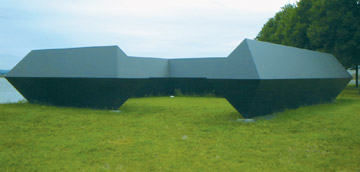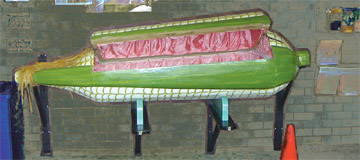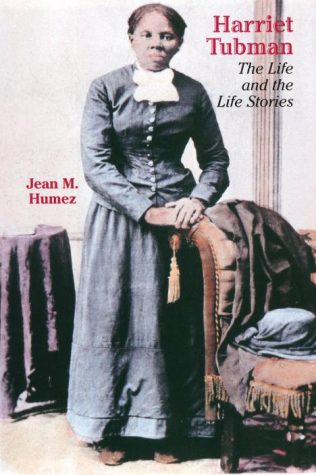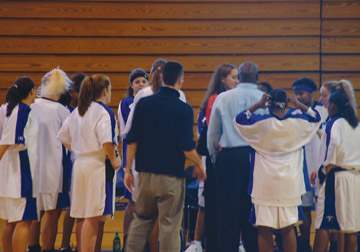UMB Art 101 or What the Heck is That?

Stinger, Tony Smith, 1999, Steel. – Photo by Kory Vergets
September 3, 2003
Welcome to the lovely seaside campus of UMass Boston. Granted, it may look like the aftermath of a demolition derby what with the bricks, cracked tiles, and various chunks of metal and cement lying around you. Yet not all of it is debris or remnants of alien civilizations. They are, in fact, pieces of art that from the Arts on the Point sculpture park made up in part of UMass faculty, art professor Paul Tucker, who acts as director of the initiative.
Parked on the front lawn of UMB is a twisted, rusted hunk of steel. It’s neither a wishbone nor scrap metal but Huru created by Mark di Suvero. Weighing in at 30,000 lbs and standing thirty feet tall, Huru is symbolic of endings and beginnings as the name means “hello” and “goodbye” in an aboriginal dialect. Although it would seem to be stationary, the tuning fork-shaped piece resting at the top of the tripod-like sculpture is capable of swiveling around even on not-so-windy days.
The piece is just as unusual as the history of the artist himself. Di Suvero began his career working with the remains of destroyed buildings. It wasn’t until an accident that left him pinned under an elevator, never to regain the use of his legs, that he learned to use an electric arc welder and crane to contort pieces of metal. Huru is, incidentally, environmentally friendly since it was created from recycled steel.
Another odd bit of art poking out of the landscape resembles the regurgitation from the latest sci-fi B movie and is actually called Stinger, based upon a conceptualization of confinement and construction, created by Tony Smith. The name is based on a cocktail of white vermouth and brandy, which goes down smoothly but gives a strong kick.
Comments may be heard ranging from questions about extraterrestrials to Big Dig leftovers yet the piece is meant to teach and provoke the viewer in the areas of comfort and space. The sculpture aims to give the watcher a sense of living in a void, and the absence of any real feeling of reality. Though it may occasionally evoke claustrophobia, the piece is not meant to be positive or negative, but a neutral plane of existence within the black, painted steel confines.
To add to the general confusion and chaos of the new semester, UMB seems to be the holding center for a couple of goth party-piñatas. However, if the individual looks past the psychedelic colors and occasional Coke can, the resemblance to caskets will be noticed. The Fantasy Coffins From Ghana are based upon the customs of the Gha and other coastal African tribes in creating a burial container that epitomizes the spirit of its owner.
The artist, Kane Kwei, started by using just a knife to bring out the image from the wood when he was fourteen years old. Discovered in the 1970s, he died in 1992 but not before teaching his younger cousin, Paa Joe, the tools of the trade. The coffins look like papier-mâché with a little paint and clear lacquer tacked on to make them shiny. The cost for these stylized caskets, however, can run US $400, a prohibitive price equivalent to a year’s salary for an African family.
The art of UMass Boston is as quirky as the campus itself. From the oddly stern visage of Luis Jimenez’s Steelworker to two perfectly constructed black cubes resting side-by-side, there are a multitude of weird and wonderful pieces that will be discussed as the semester progresses. One good way to pass a weekday afternoon is to attend the brown bag lunches, “Art/Talks,” held in the Harbor Art Gallery or visit the website: www.artsonthepoint.org for in-depth analysis.























































